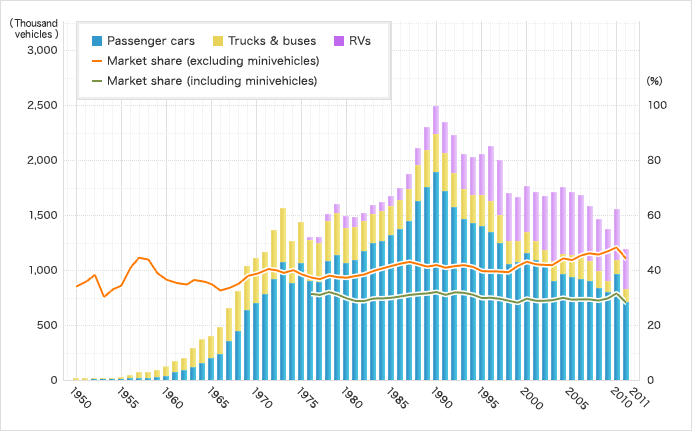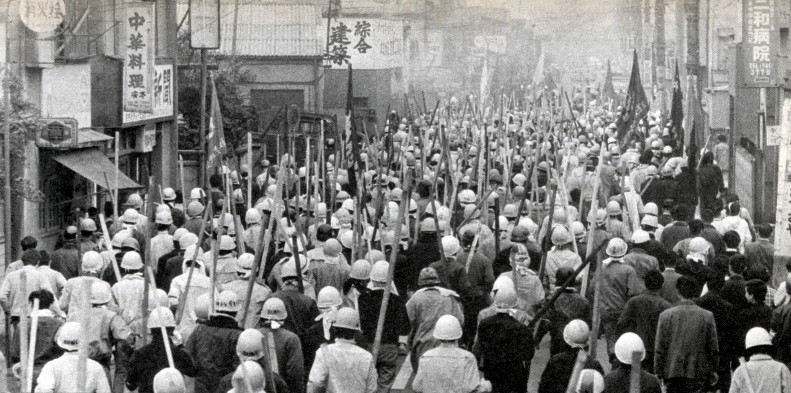End of the Yoshida Doctrine
- Yoshida Doctrine
- Satō Non-Nuclear Policy
- Nixon Shock(s)
- OPEC
- Bretton-Woods
- Nakasone Yasuhiro
- Maekawa Report
- "Just in Time" Manufacturing
- "Galapagos Syndrome"
“Yoshida doctrine”
- Economic growth should be Japan’s prime national goal. Political and economic cooperation with the US is necessary to acheive this goal
- Japan should remian lightly armed and avoid involvement in international disputes. In dpoing so, Japan would avoid the diversion of energy and resources from its primary goal -- economic growth
- In order to secure American cooperation and ensure its own security, Japan would along for US troops to be stationed Japan
- Central to this doctrine is that Japan is not a major player in world politics
Ikeda Hayato (1899-1965), PM 1960-64
-
Focus on economic growth and reducting domestic tensions
- "Income Doubling Plan": focused on balanced growth across economic sectors and companies size
- Social welfare: national health insurance
- Price supports for farmers
- Protection for small business: see department store regulations
- Coopt (rather than combat) labor unions: emphasize that productivity will be shared with job security, higher wages
Satō Eisaku (1901-1972) PM 1964-1972
- prime minister from 1964-1972, the longest term in Japanese history
- Kishi Nobusuke’s brother (Kishi was adopted-out of Satō family)
- Continues US Japan Security Treat (Anpo
安保 - 日米安保条約)
- BUT in 1967 modifies it to assuage popular concerns
- Japan’s Three Non-Nuclear Principles
1) Japan will not produce nuclear weapons
2) Japan will not possess nuclear weapons
3) Japan will not permit the introduction of nuclear weapons on its territory
- Three Principles of Arms Export
1) not allow the export of weapons to the Communist Bloc
2) not allow the export of weapons to countries covered by UN arms embargoes
3) not allow the export of weapons to countries likely to be involved in armed conflicts
-
Informal policies
- SDF spending should not exceed 1% of GNP
- SDF is constitutional, but Constitution enjoins them from being dispatched, even as part of UN peace-keeping missions
- Satō is awarded 1974 Nobel prize for Nuclear Non-Proliferaton
- His acceptance speech emphasized
- Reversion of Okinawa
- Asian Development Bank
- Normalization of Relations with Republic of Korea
- Overseas economic boom
- Example, surge in domestic autosales — chart is from Toyota
- Japanese domestic passenger car sales
- 1960 about 100,000
- 1970 about 1,800,000
- 1973 about 2,800,000

US Imports of Japanese Automobiles

Student radicalism continues, but it is increasingly isolated from mainstream politics
- Increasing fragmentation and marginalization of the student left
- Violent fighting between factions esp. Kakumaru-ha 革マル派
and Chūkaku-ha 中核派
 |
1967 protests against Satō visit to US |
|
1969 anti-war, anti-Anpo protests |
Nixon shocks of 1971-73: the beginning beginning of trouble in US-Japanese alliance
- US recognizes Beijing (PRC), rejects Taiwan, without informing Tokyo beforehand
- US abandons Bretton-Woods, floats the dollar and allows it to fall
- US demands restrictions of Japanese textile exports to US (Nixon threatens to impose restrictions unilaterally under the Trading with the Enemy Act)
Arab Oil Embargo

Nakasone Yasuhirō (1918-, PM 1982-87)
- Something of a political outsider: first in his family to go into politics
- Naval officer (paymaster)
- Wrote directly to MacArthur insisting that Japan should have army
- As PM he believes that Japan need to rethink alliance with US as an equal
- "Nakasone Doctrine" to replace "Yoshida Doctrine"
- Age of American supremacy was ending
- Japan will be economic giant of 21st century
- Japan can and should be less protectionists
- Nakasone commissioners official government report to support his views
- "Maekawa Commission" — not MITI, EPA, MoF
- "It is necessary to view a continuation of Japan’s large imbalance in the current trade account as a crisis condition not only in managing our own economy but also in the cooperative development of the world economy. Today, Japan has entered a period in which historic changes must be made in its economic policies as well as in the lives of the people. Without such changes, there can be no progress for Japan."
- "In order to create an internationally cooperative economy and for Japan to become a truly international state, it is essential that Japan endeavor to achieve economic growth, led primarily by domestic demand, as well as to promote fundamental changes in its trading patterns and industrial structure . . . To achieve these goals, the roles of government finance, including the tax system and monetary policy, are important. Thus, there is a special need to make a fundamental reexamination of the tax policies promoting saving."
- Proposed Policy changes
- 1) increase domestic demand
- 2) transform the industrial structure to reduce trade surplus
- 3) improve access to Japanese markets and promote the import of foreign manufactured goods
- 4) cooperate in international efforts to stabilize exchange rate
- 5) make contributions to the world economy appropriate Japan’s position . . . (foreign aid
- 6) change fiscal and monetary policies to reduce trade surplus
- Domestic response
- "Ron Yasu"
- LDP rejects Nakasone's plan
- "It is simply unforgivable to make such promises at a meeting of the heads of state regarding Japan’s policies; the party has not been consulted."
- BUT, success on JNR and "metal bats" (cf. 1981 NY Times story)
- Pushed for strong Japanese military
- Despite opposition from former PN Fukuda and Suzuki - pushed through a military budget which exceeded 1% of GNP -- the 1986 military budget was 1.004% of GNP
- Argued that Japan had to be able to control the Sea of Japan, so as to be able to bloc the passage of Soviet submarine into the Pacific during time of crisis
- Argued for an expansion of Japanese airpower so as to stop the overflight of Soviet bakcfire bombers -- “unsinkable aircraft carrier.”
- Hinted at constitutional revision
- Education reform: New era requires new educational system for Japan
- Nakasone's Ad Hoc Council on Administrative Reforms
- Rote education was fine when Japan was catching up
- But Japan now needs to encourage bold thinkers to create new knowledge -- not just adapt foreign technology
- "We imported and adopted from Western advanced industrial countries
such things as their advanced technology and systems, and we emphasized
efficiency in order to swiftly promote their dissemination. From a broader
perspective, in terms of both content and method, the result of nothing less
than a rigidly uniform education system was preordained."
- "However, it is undeniable that Japan’s traditional education has mostly rested
upon the tendency of cramming knowledge by rote memorization. The society
of the future will require us not merely to acquire knowledge and information,
but to further develop the ability to express, create, think with our
heads, and to make an appropriate use of that knowledge and information.
Creativity is closely connected to individuality, and only when individuality
is fostered can creativity be nourished."
- Need to move beyond “knowledge-cramming,” “rigidly uniform,” “entrance exam–based” knowledge
- In favor of “new concept of scholastic ability," and “a self-driven appetite
for learning as well as the ability to independently respond to social change.”
- Bullying is understood as failure of both moral education and lack of individual attention
- This bold new Japan can also be more patriotic — emphasis on "moral education"
- Also more cosmopolitan
- Nakasone hopes for bold radical change:
- Change in university entrance exams: more flexibility in schedule and content
- New "gifted" programs
- Creative teaching approaches with focus on individual
- Breaking teacher's union would be added bonus
- But key reforms are diluted and delayed by entrenched bureaucracy
- Failure to increase budgets and teacher/studetn ratios
- Delinquency problems of "lost decade"
- Lack of integration with broader corporate norms
- Panic of the 2006 over test scores Exam stats
- Visits Yasukuni Shrine and signs in as PM in 1985 . . . but not in 1986
Recruit Scandal 1988
- Massive insider trader scandal
- Hiring/personel company called "Recruit" gives shares to politicians just before 1986 IPO
- Bribed mostly LDP, but also Socialists and Kōmeitō
- Topples Takeshita cabinet (PM 1987-89)
- Takeshita had also pushed through consumption tax and import liberalization
Uno Sex Scandal (1989)
- Topples Uno Sōsuke cabinet
(June 1989 to August 1989)



